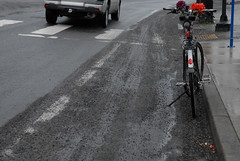A new paper to be published later this year by a team of doctors and nurses from Oregon Health Sciences University (OHSU) has found that roadway conditions and “the commuting environment” play an important factor in the incidence rate of injuries sustained while riding.
The paper, Bike commuter injury prevention: it’s time to focus on the environment, is the result of a study launched back in September 2007. It tracked 962 people who ride their bikes to work and it monitored them through monthly surveys.
According to the paper’s primary author, Red Hoffman, ND, there were three specific aims of the study: to determine the volume and severity of “traumatic events” (injuries) that happened to the subjects, to determine how the subject’s personal characteristics (such as skill level or age) might have contributed to the injury, and to learn how “environmental factors” such as roadway surface conditions influence the rate and severity of the injuries.
The study subjects were evenly split between male and female, ranged in age from 22 to 70 years old, and commuted by bike an average of 135 miles per month. As for riding skill level, 23% were beginners, 27% were intermediate, and 50% were advanced.
Hoffman says the incidence rate of “traumatic events” (which led to injuries) was 15 per 100,000 miles ridden and the incidence for “serious traumatic events” (which led to injuries requiring medical attention) was 3.9 per 100,000. Or, put another way, during the one-year study, nearly 20% of bike commuters in the survey experienced a “traumatic event” and 5% required medical attention.
The study found that, “There were no differences in age, gender, safety practices and experience levels between commuters who experienced a TE [traumatic event] and those who did not.”
“One finding I thought was interesting,” said Hoffman, “is that poor roadway surface conditions played a role in 20% of the traumatic events — gravel on the road, rail tracks on the road, steel plates in the road, and so on… led to these events.”
The study also found that 48% of the “serious traumatic events” involved motor vehicles.
Hoffman presented the paper at the annual meeting of the Eastern Association for the Surgery of Trauma last month and she won the John M. Templeton, Jr., MD Injury Prevention Paper Competition.
The paper will be published in the Journal of Trauma later this year (I’ll do a follow-up story with a link to the full paper once it’s published). Co-authors on the paper were William Lambert, PhD and Ellen Peck, RN. The Principal Investigator was John Mayberry, MD.


